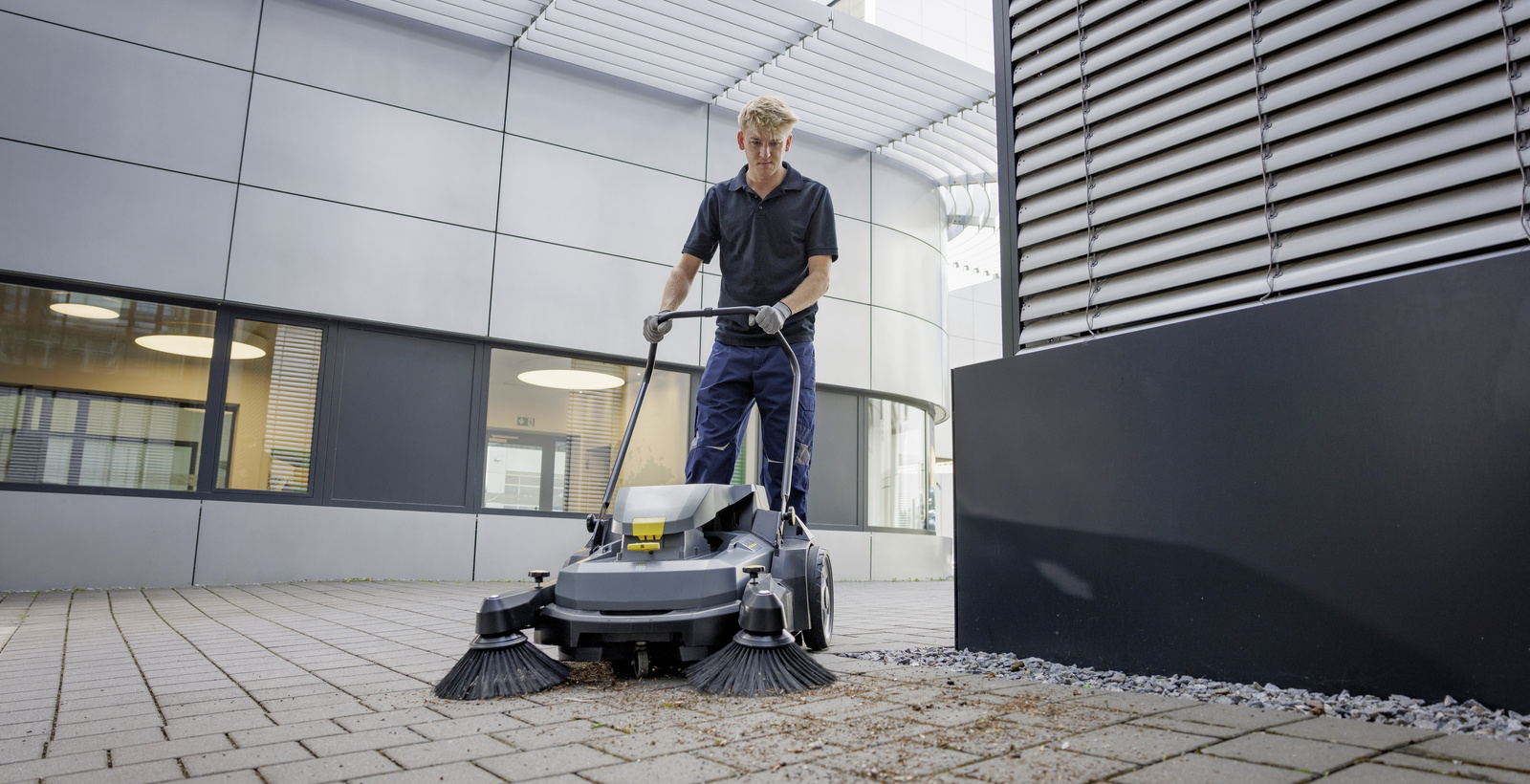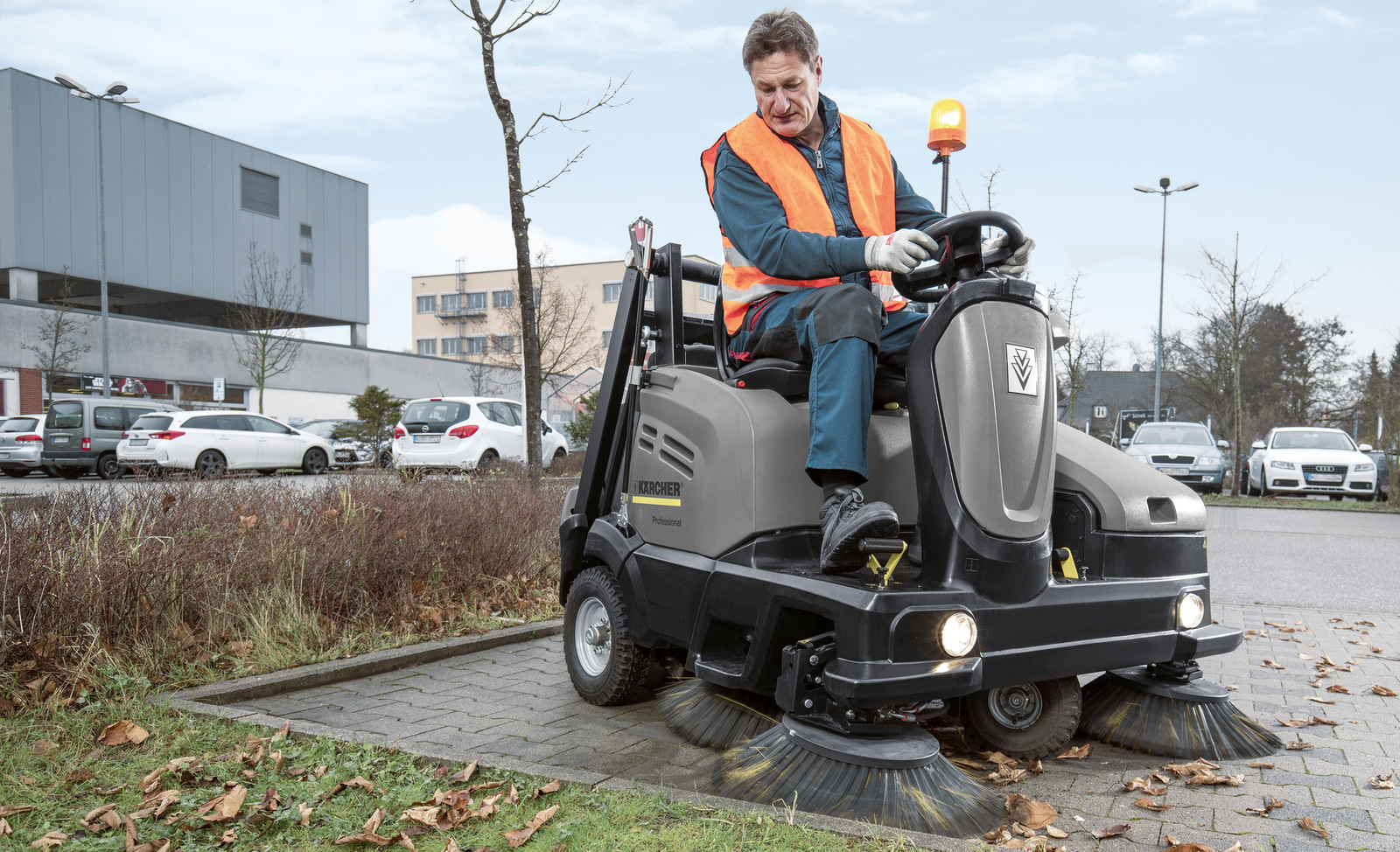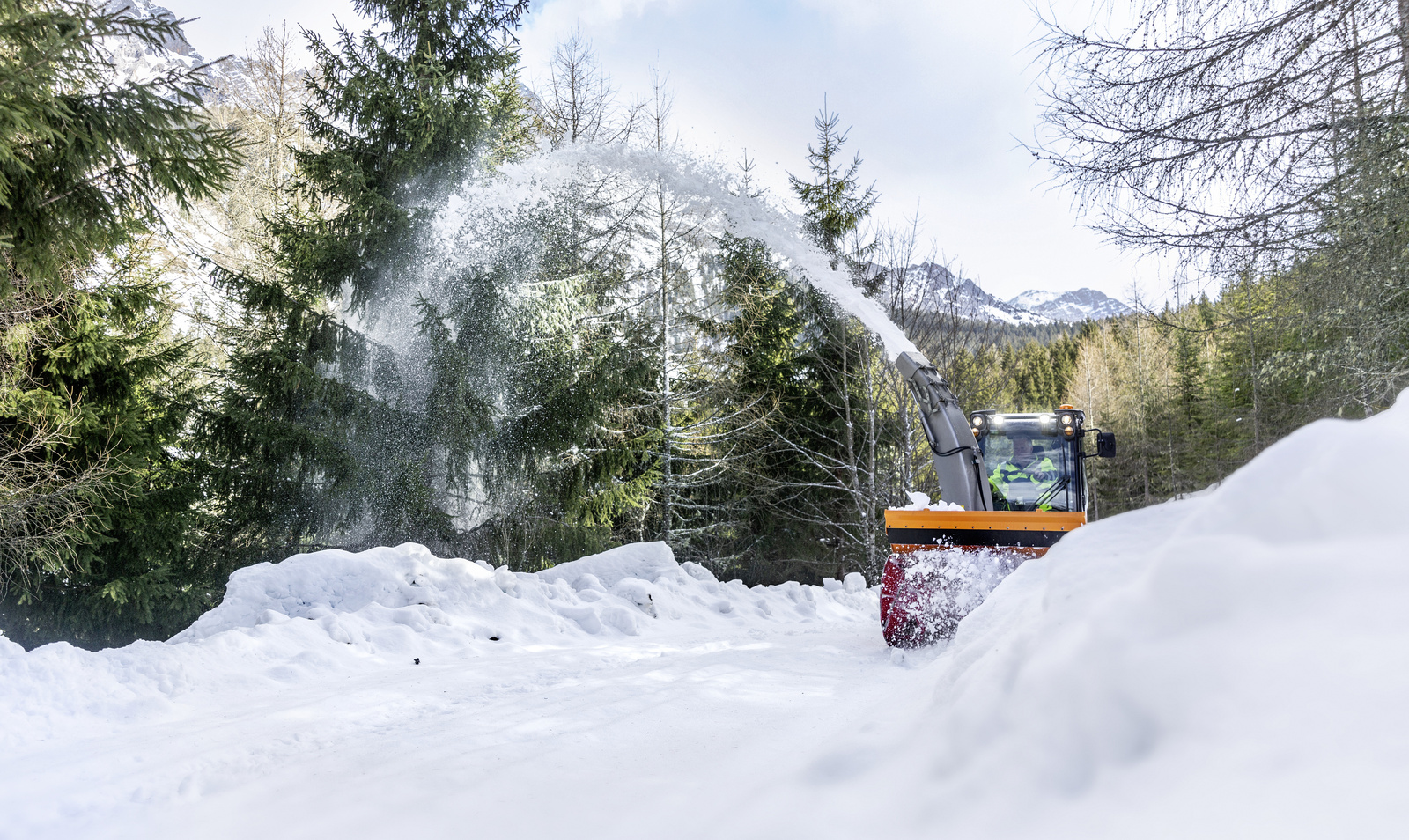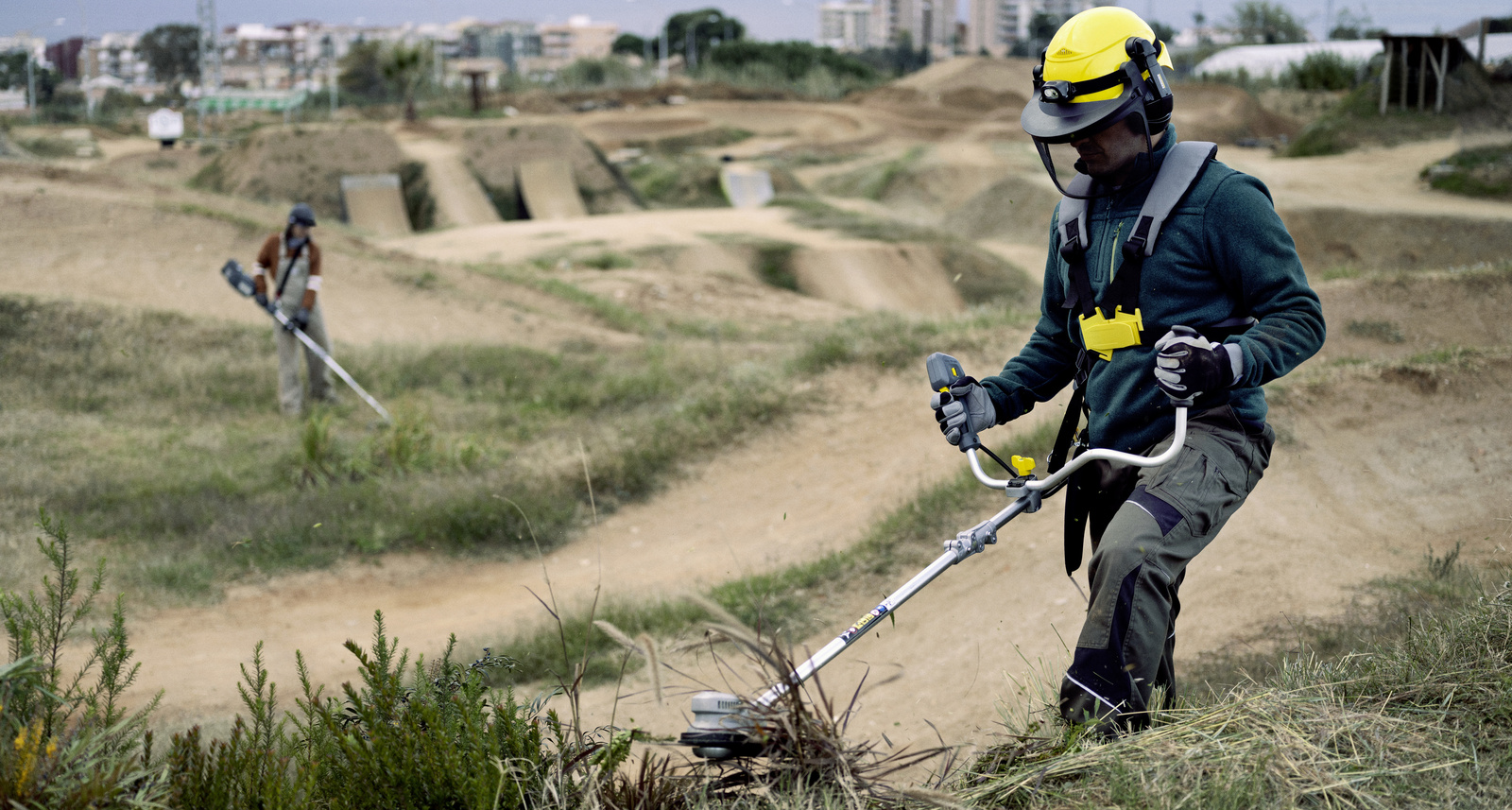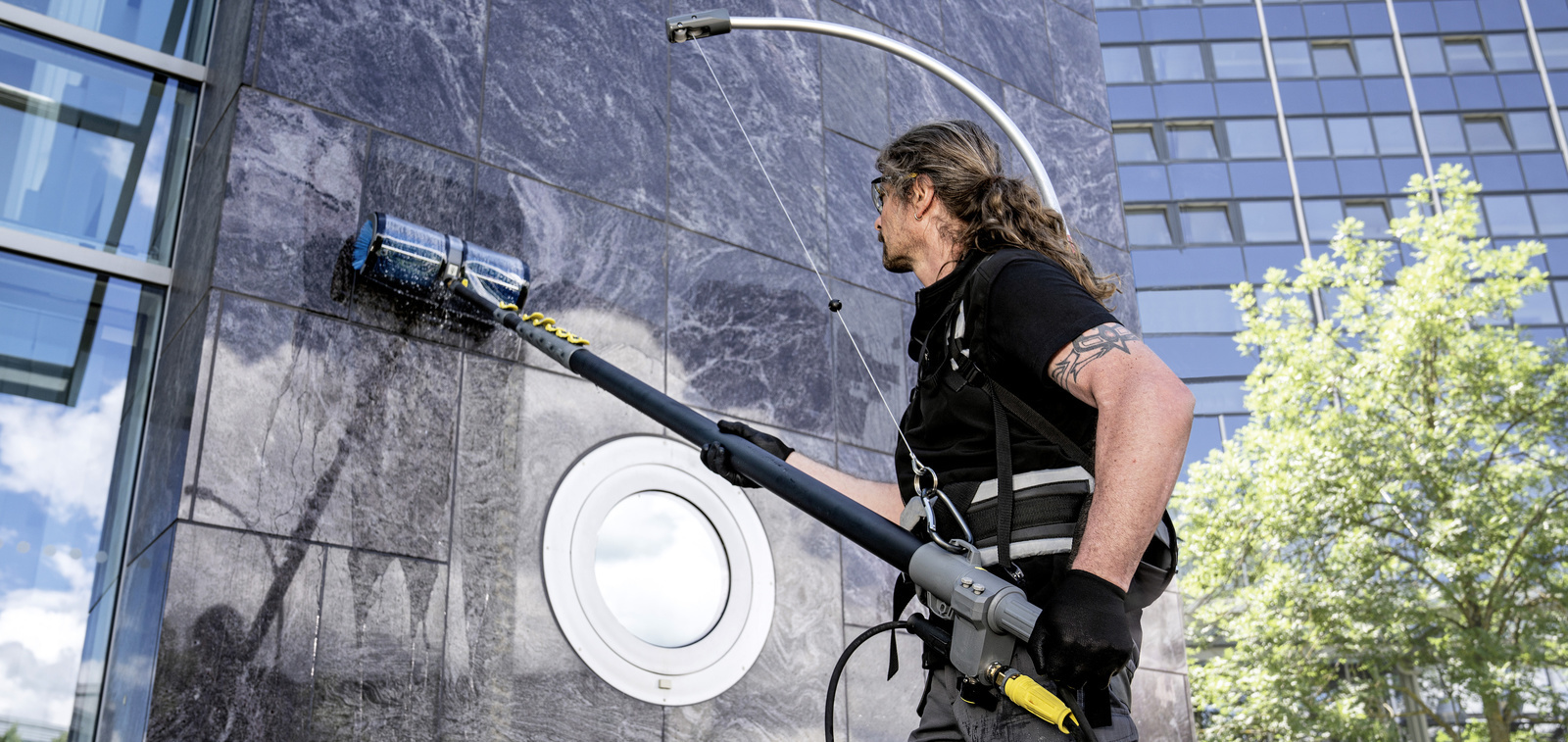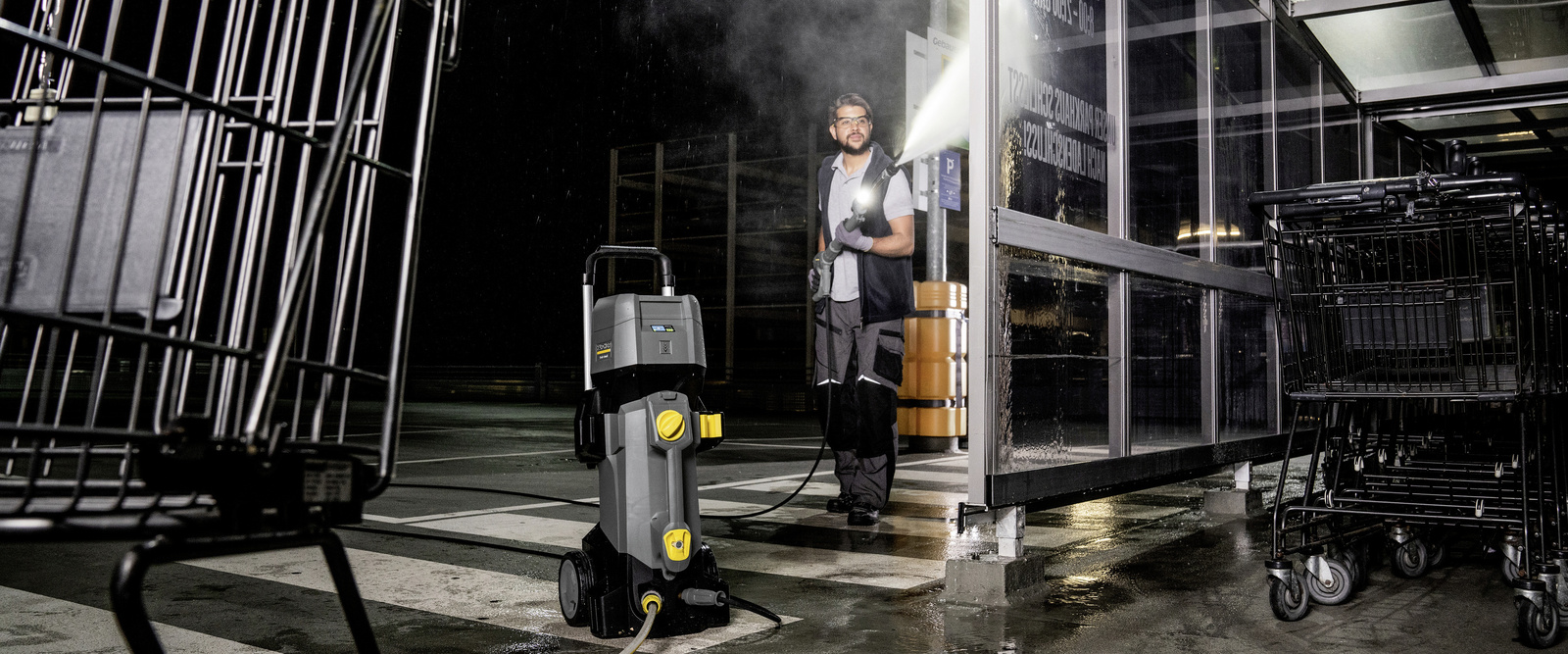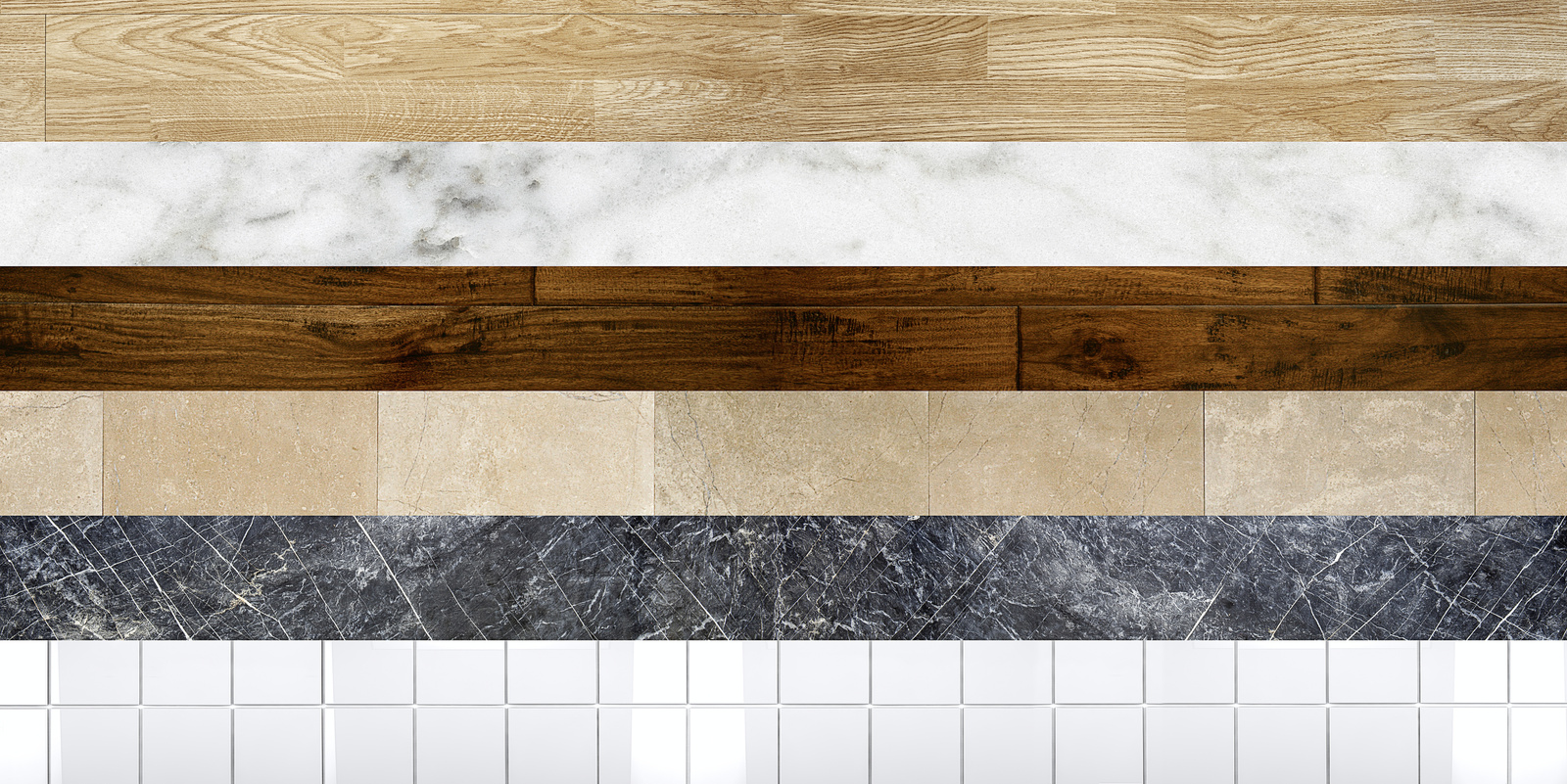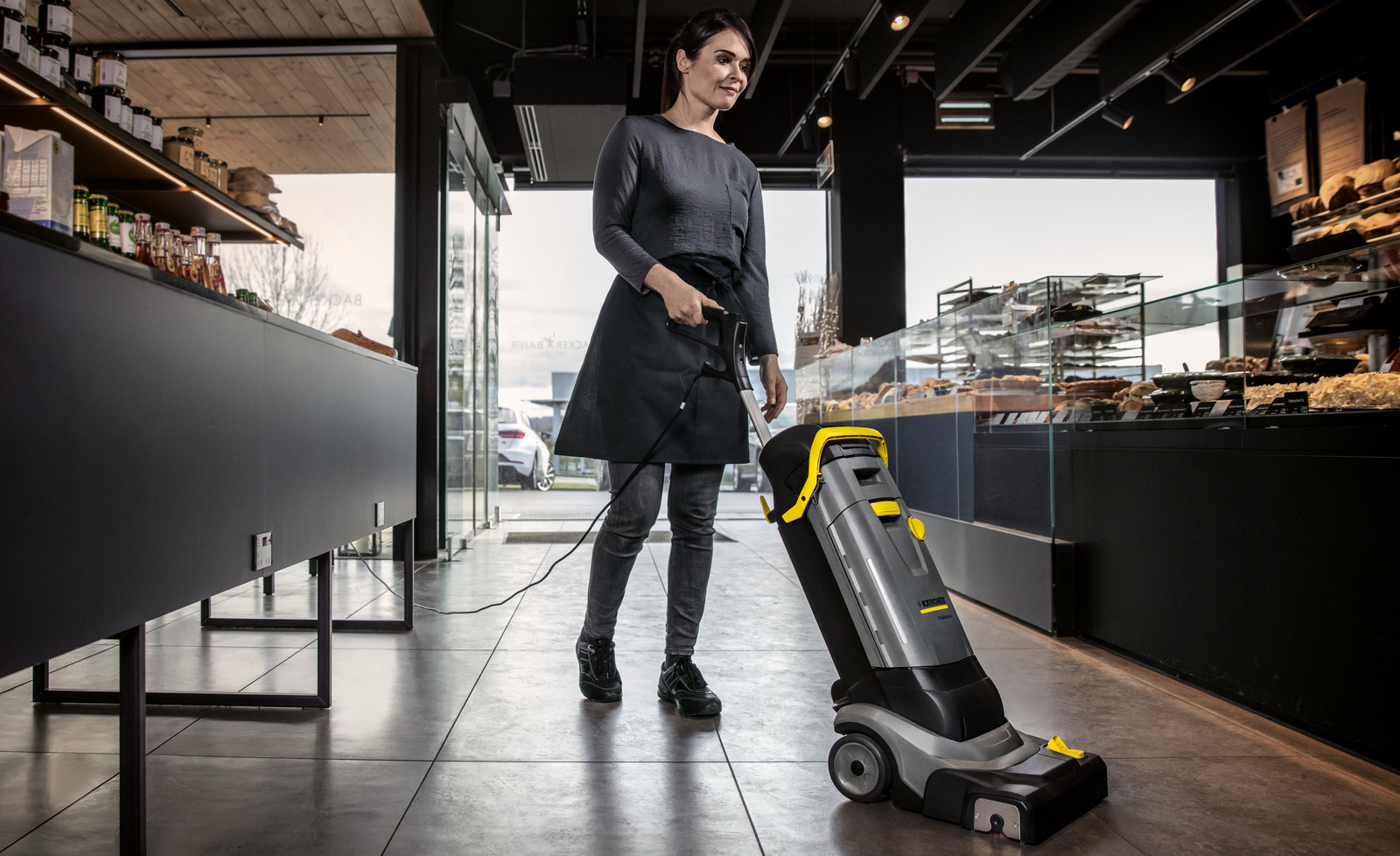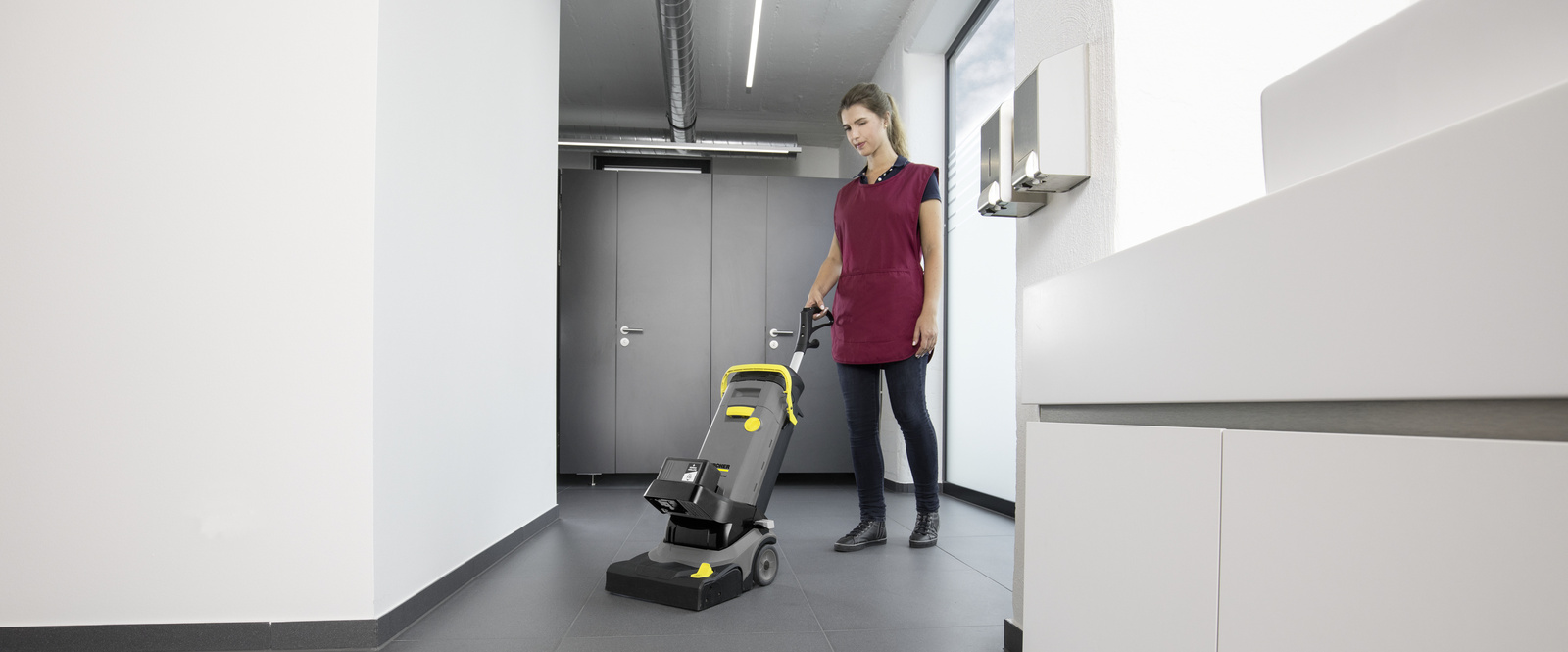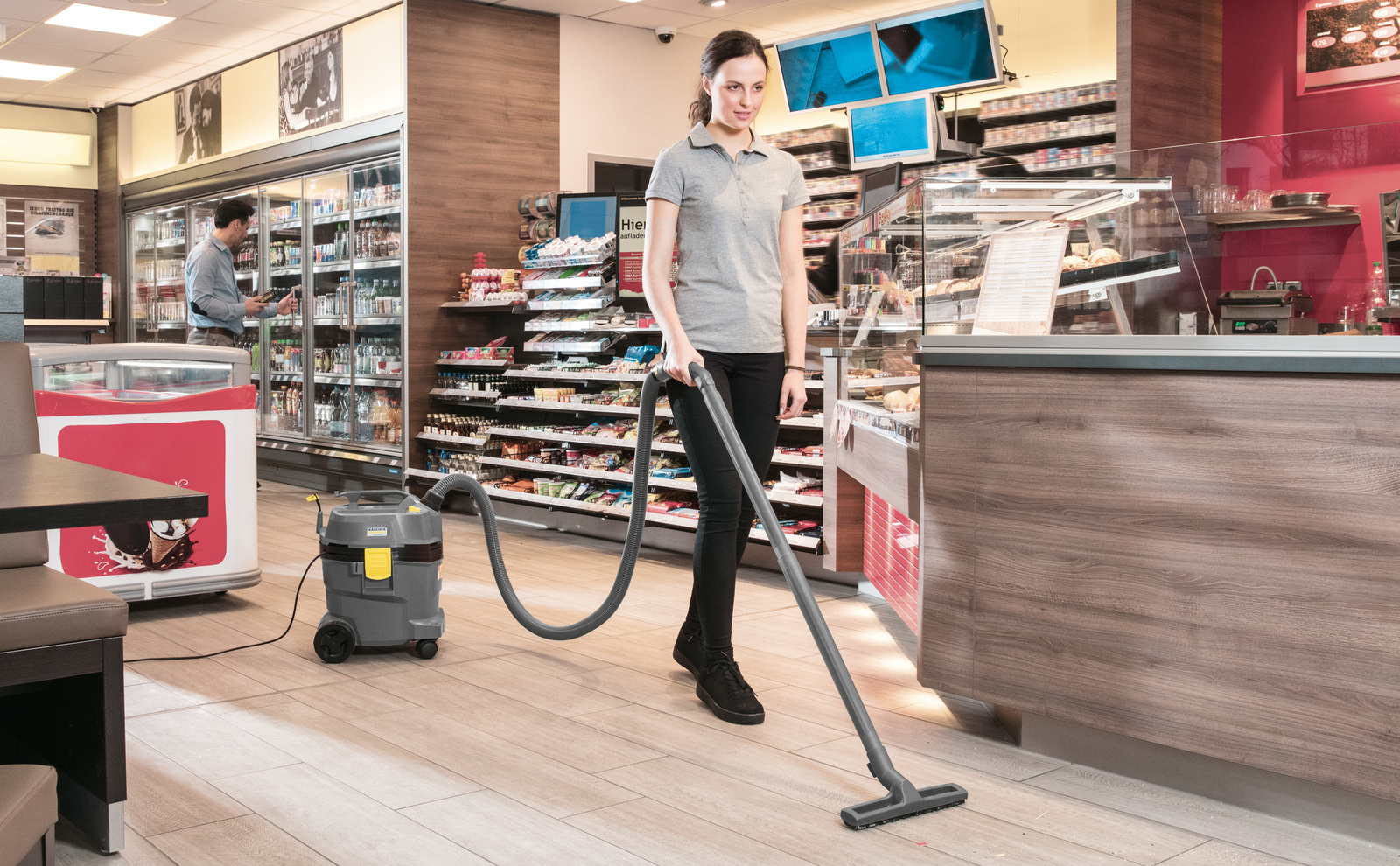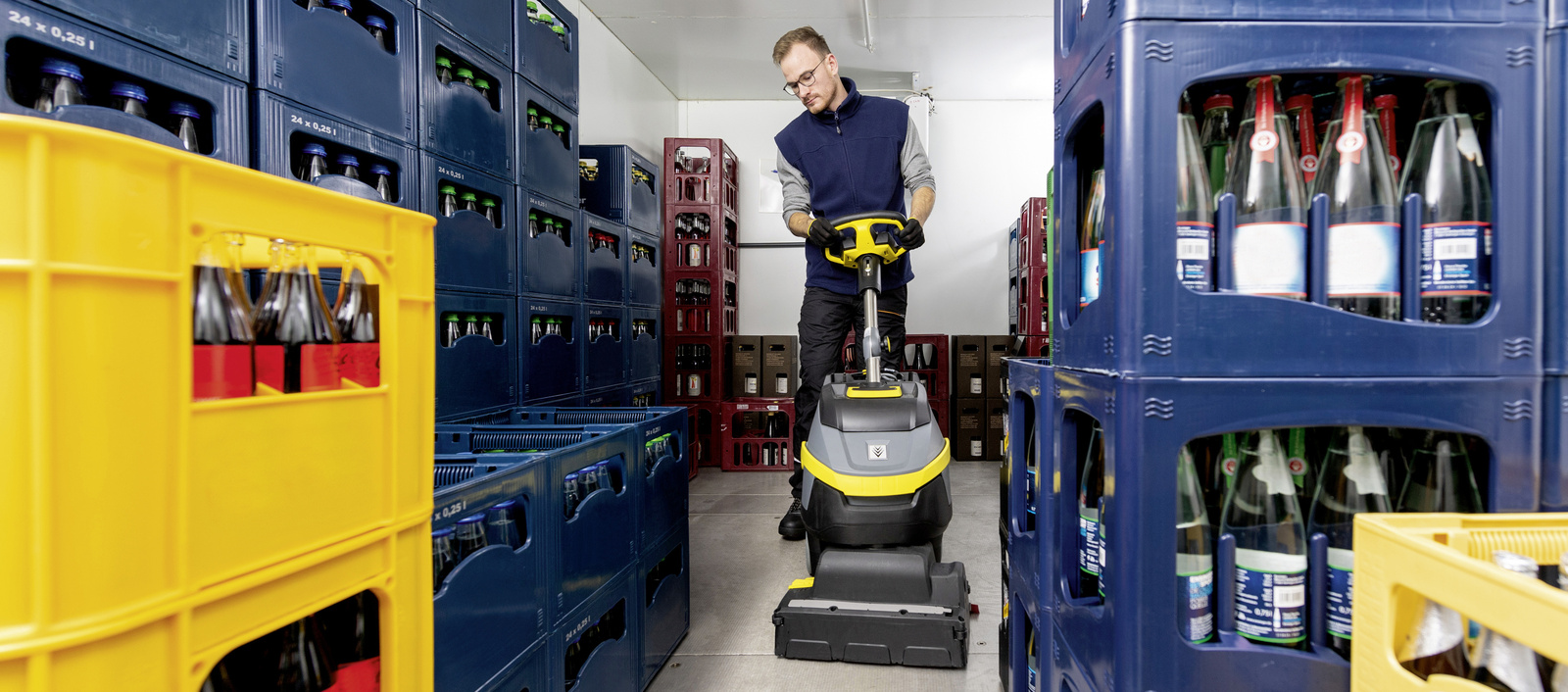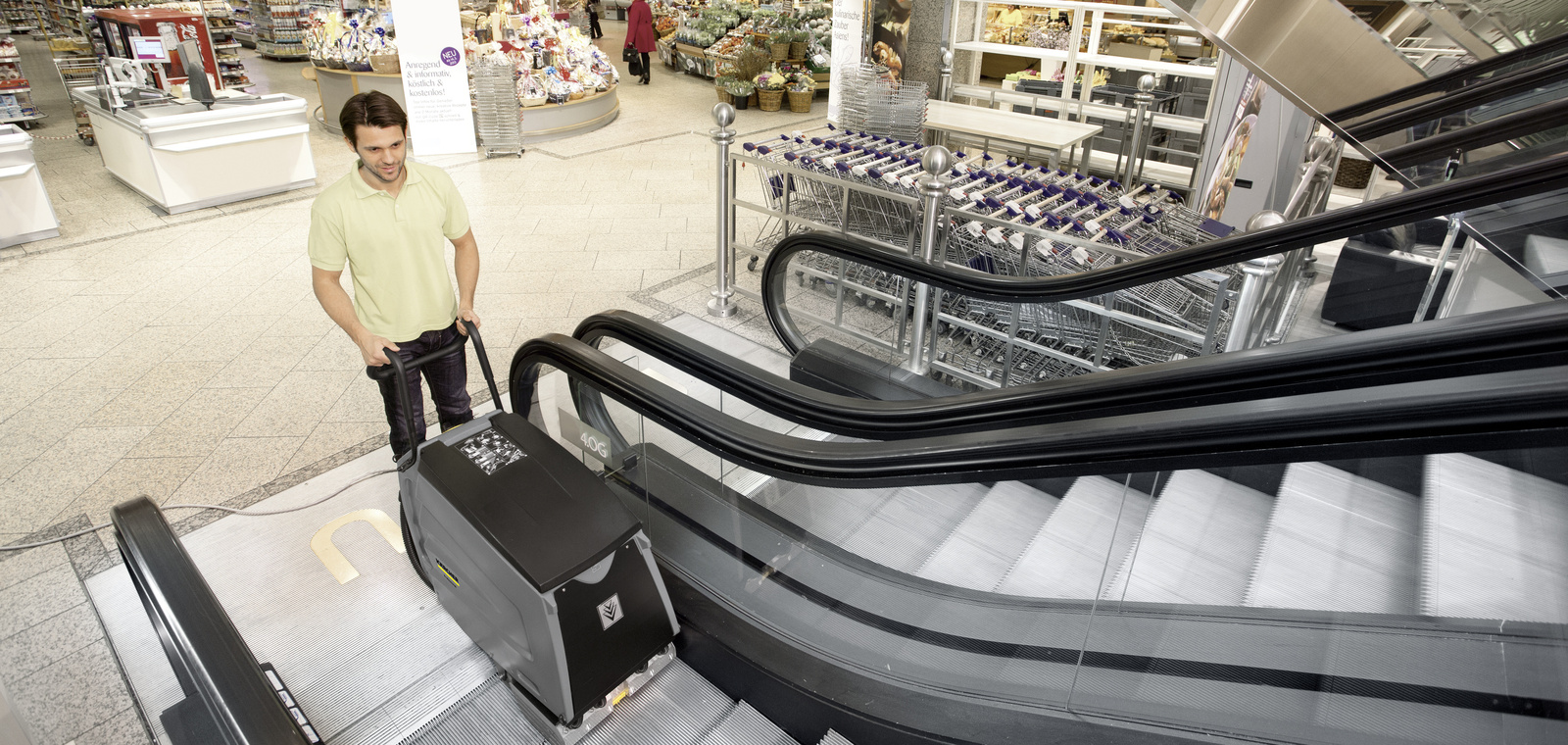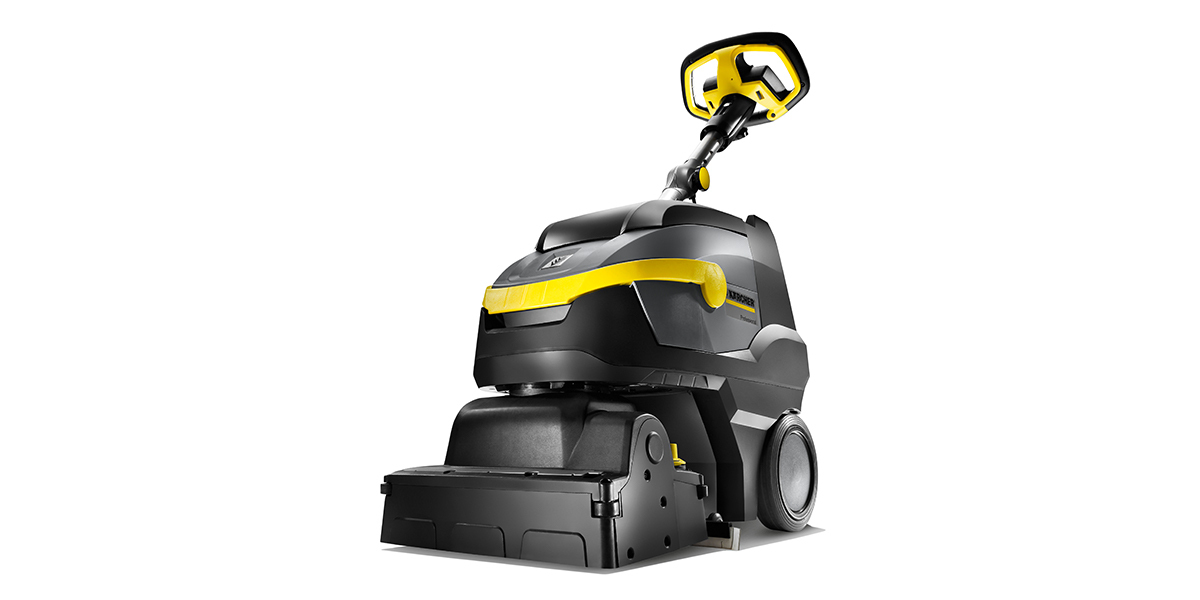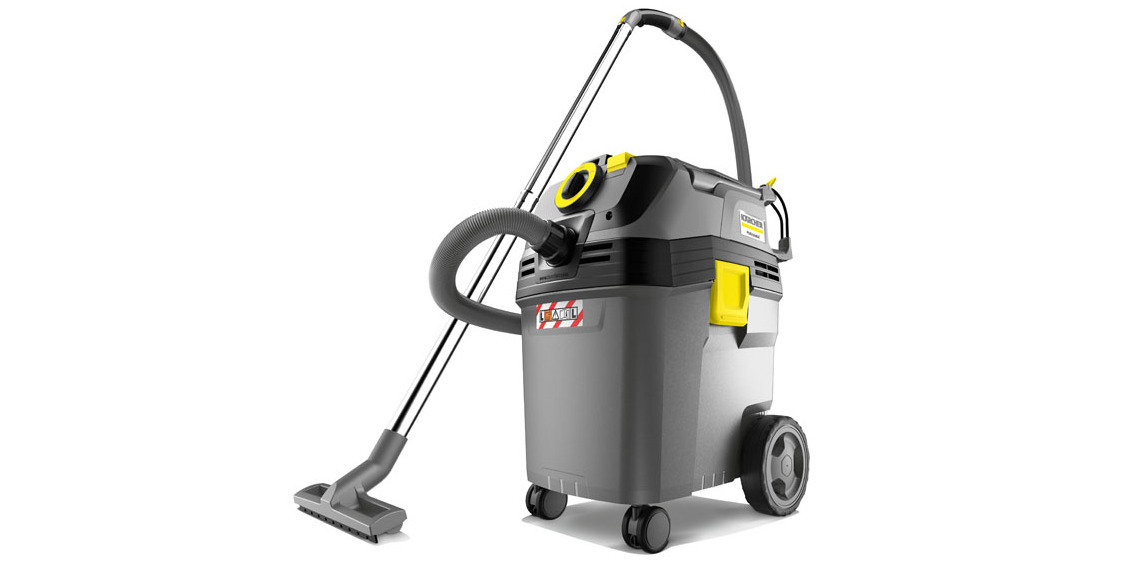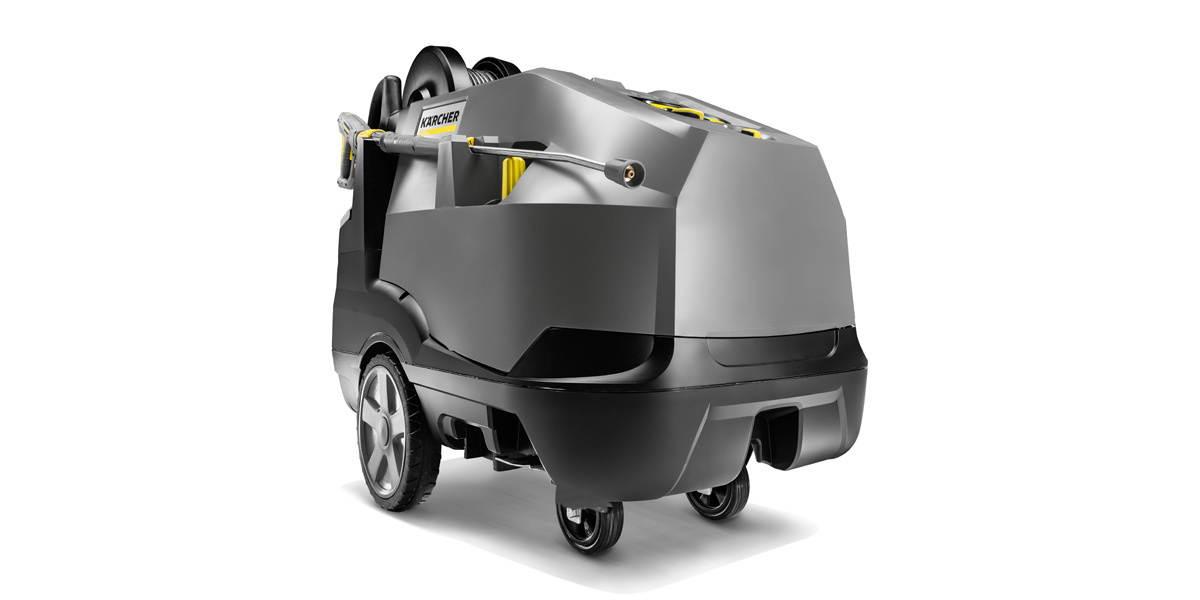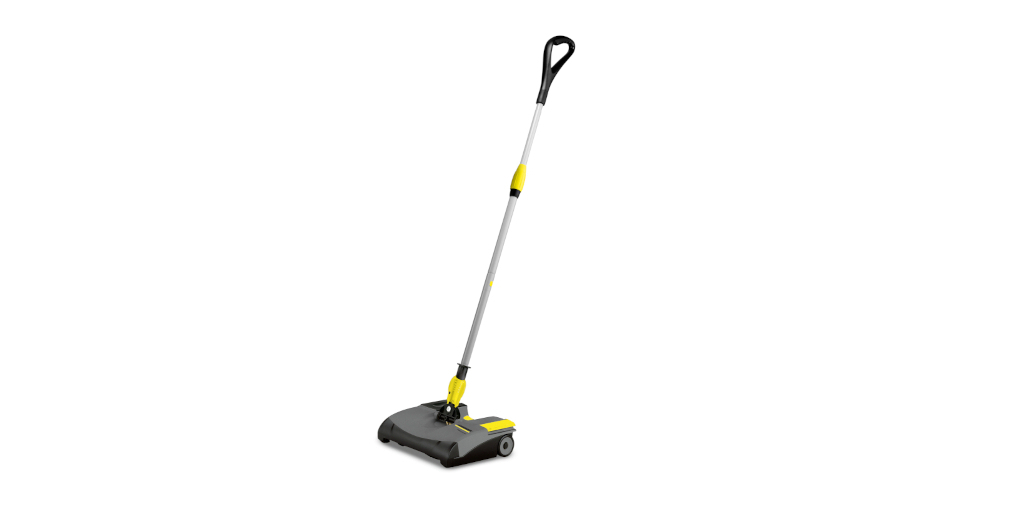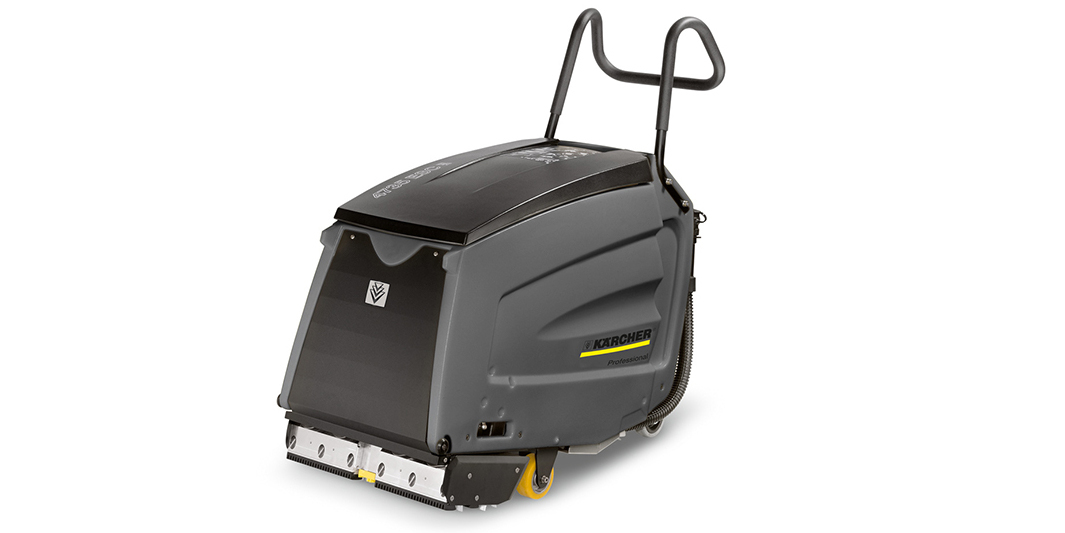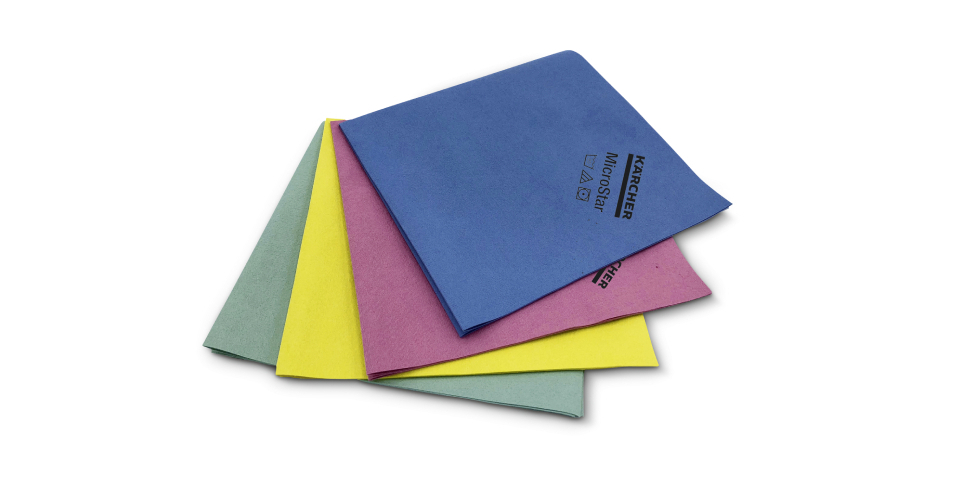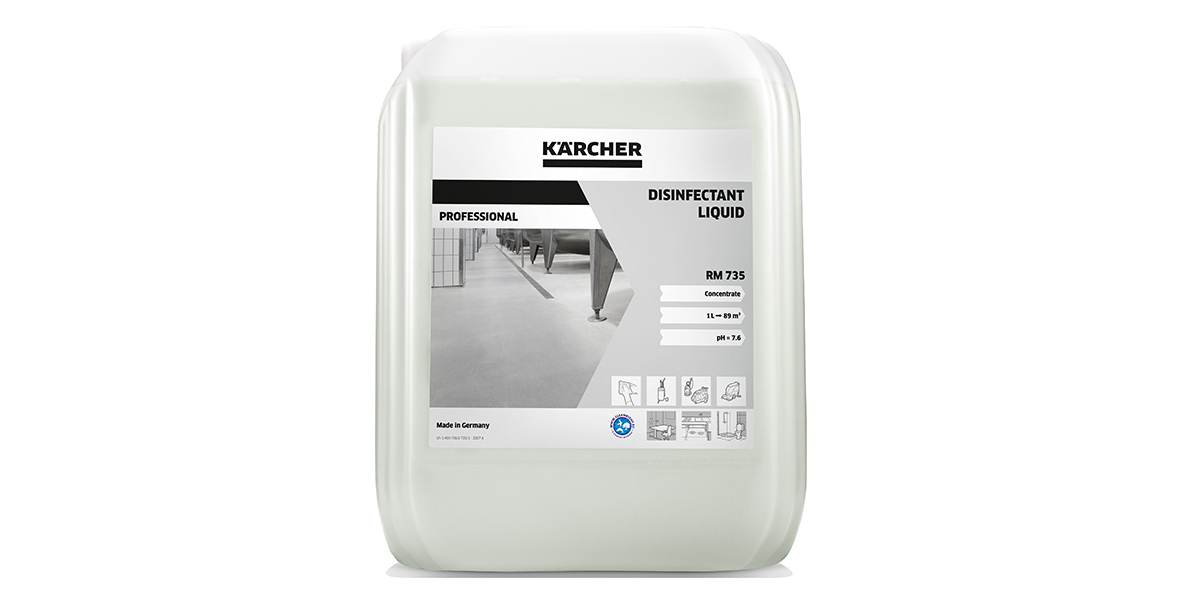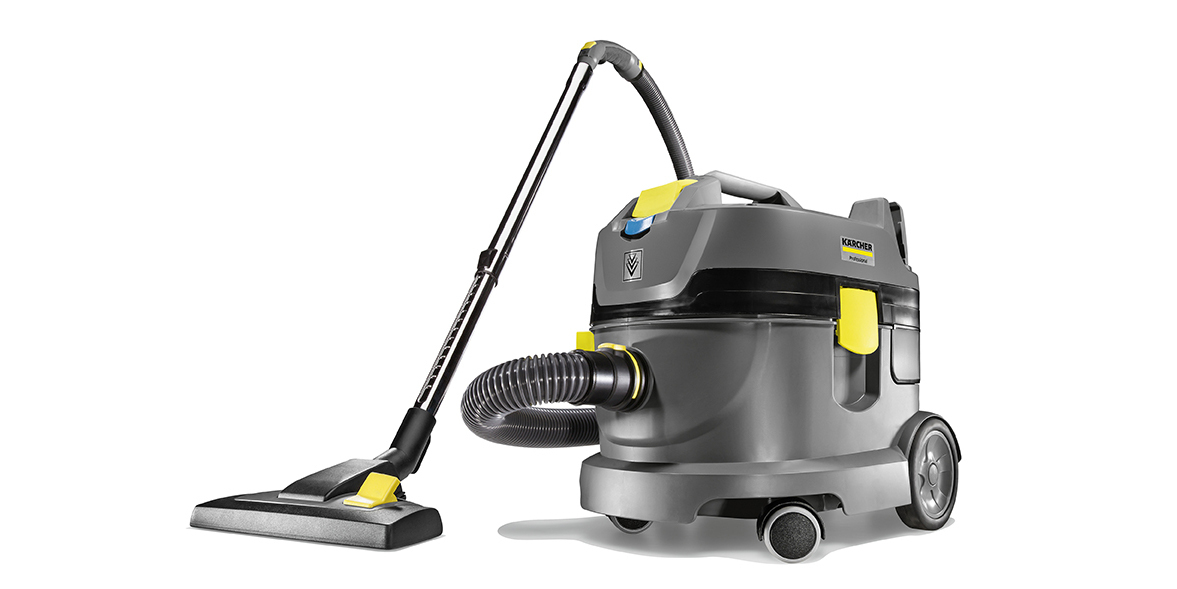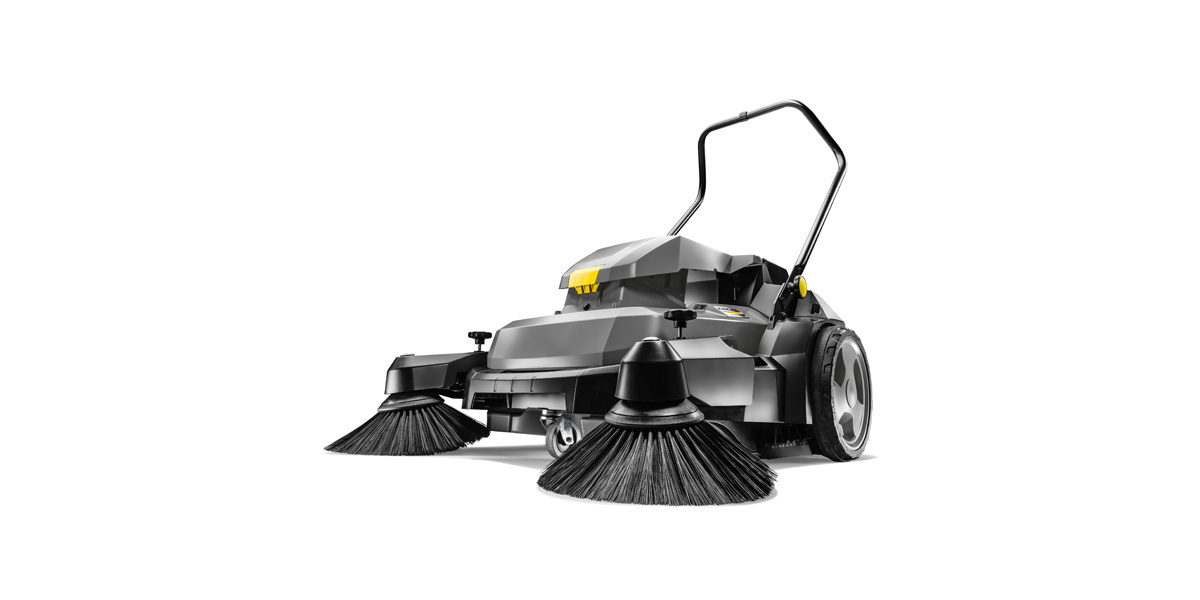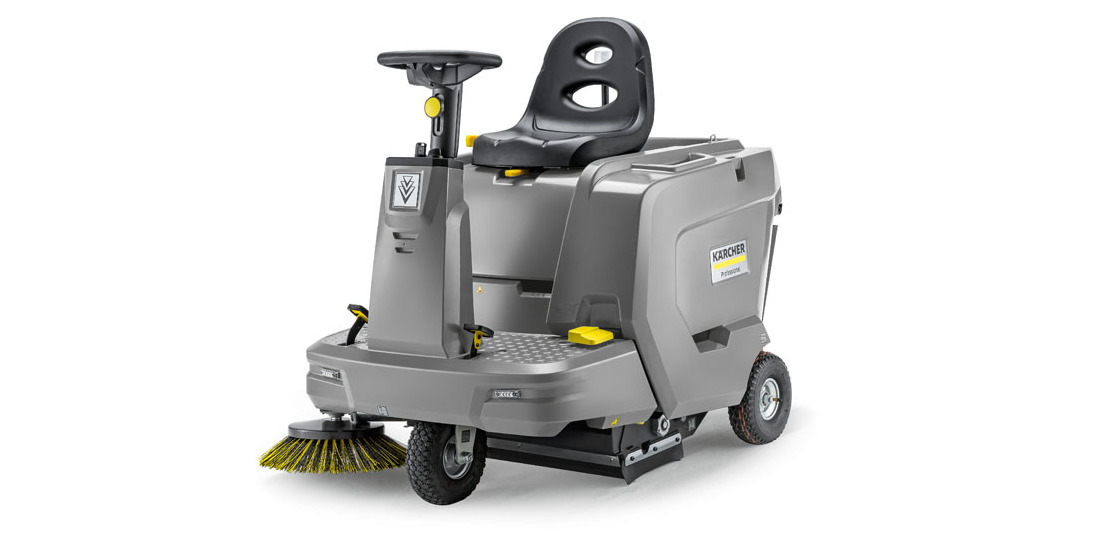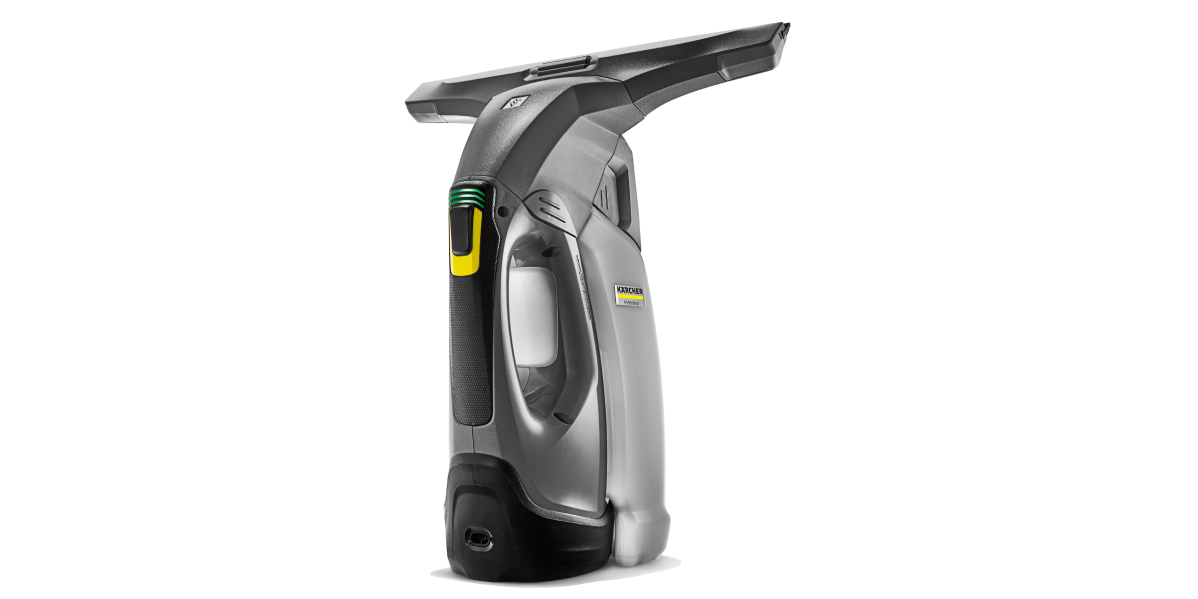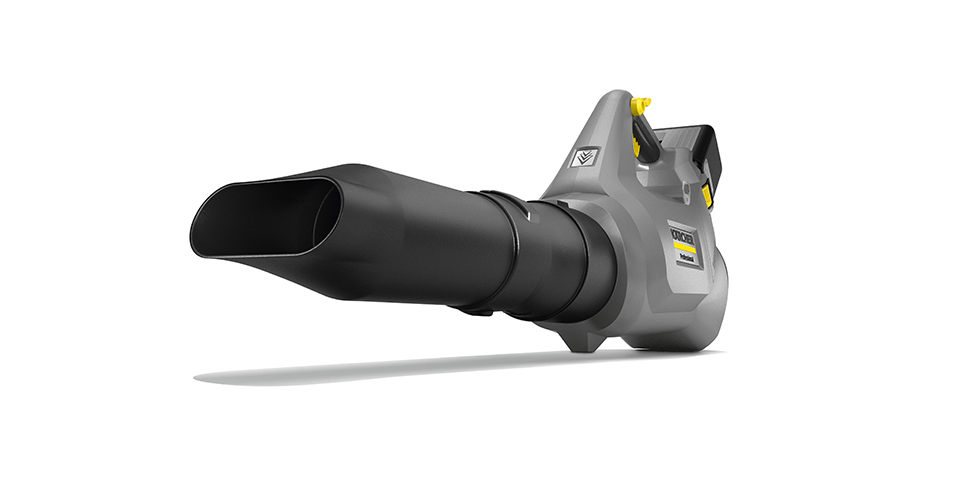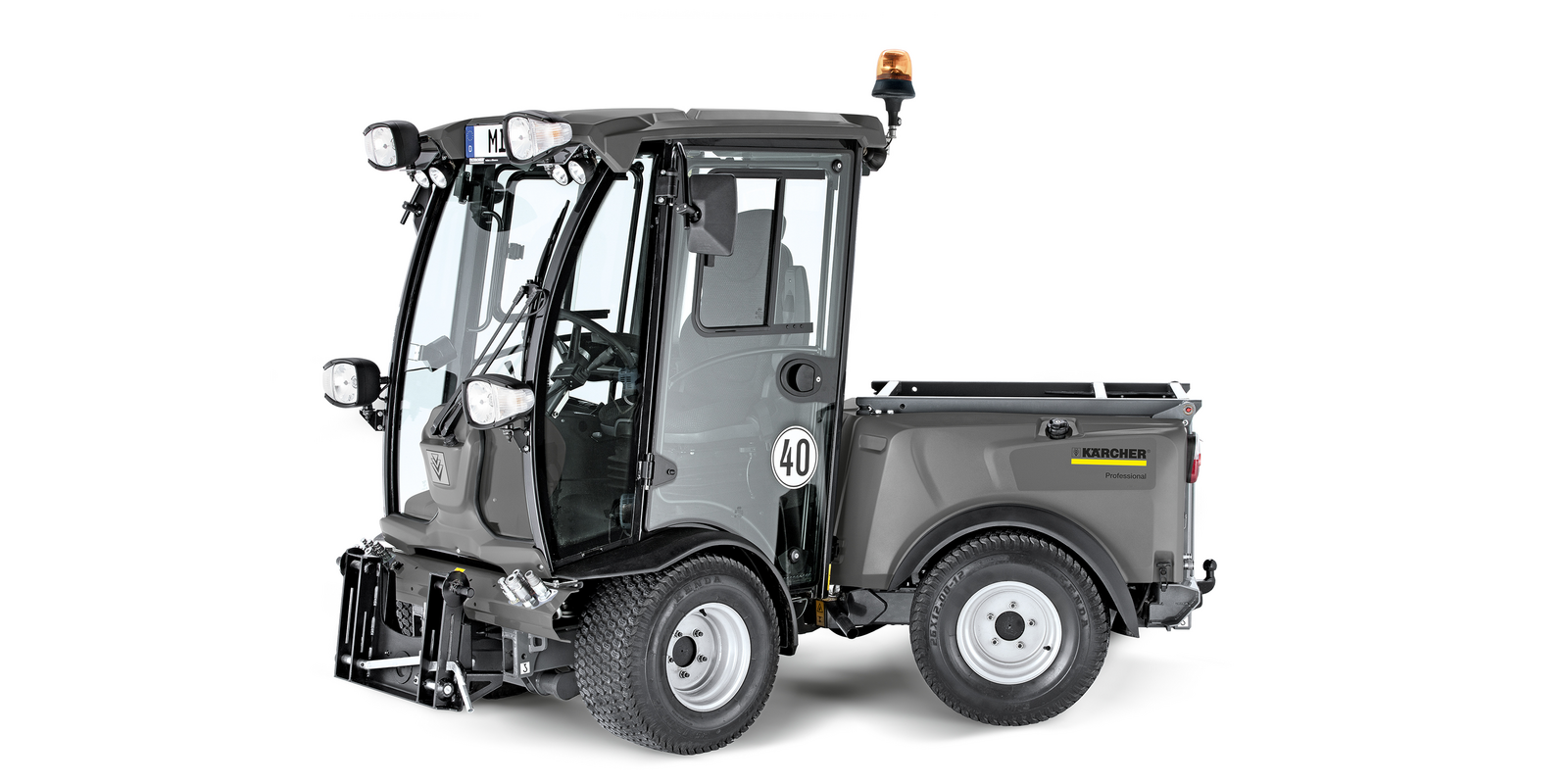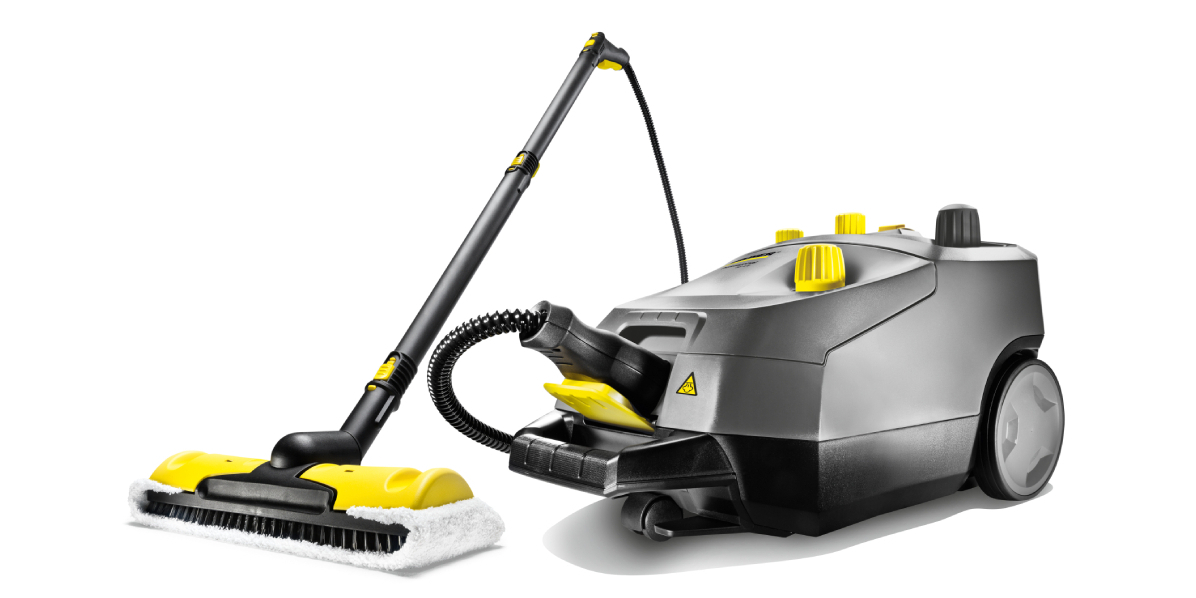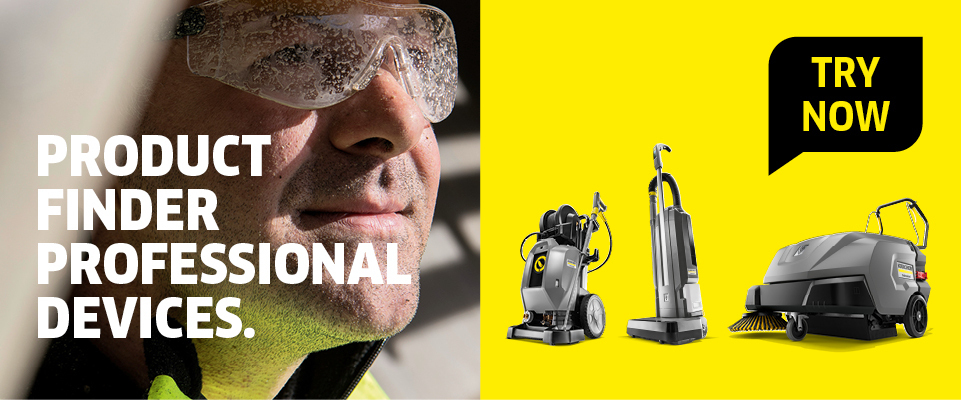Cleaning supermarkets
From the oven of the in-store bakery to the glass surfaces at the deli counter and the freezer cabinets, cleaning a supermarket is a varied and demanding task. Hygiene is also a key issue on surfaces that come into direct contact with skin and/or food. A consistent cleaning concept is needed to give customers peace of mind and enjoyment when they shop. Choosing the right technology is just as important as keeping an eye on the relevant details.
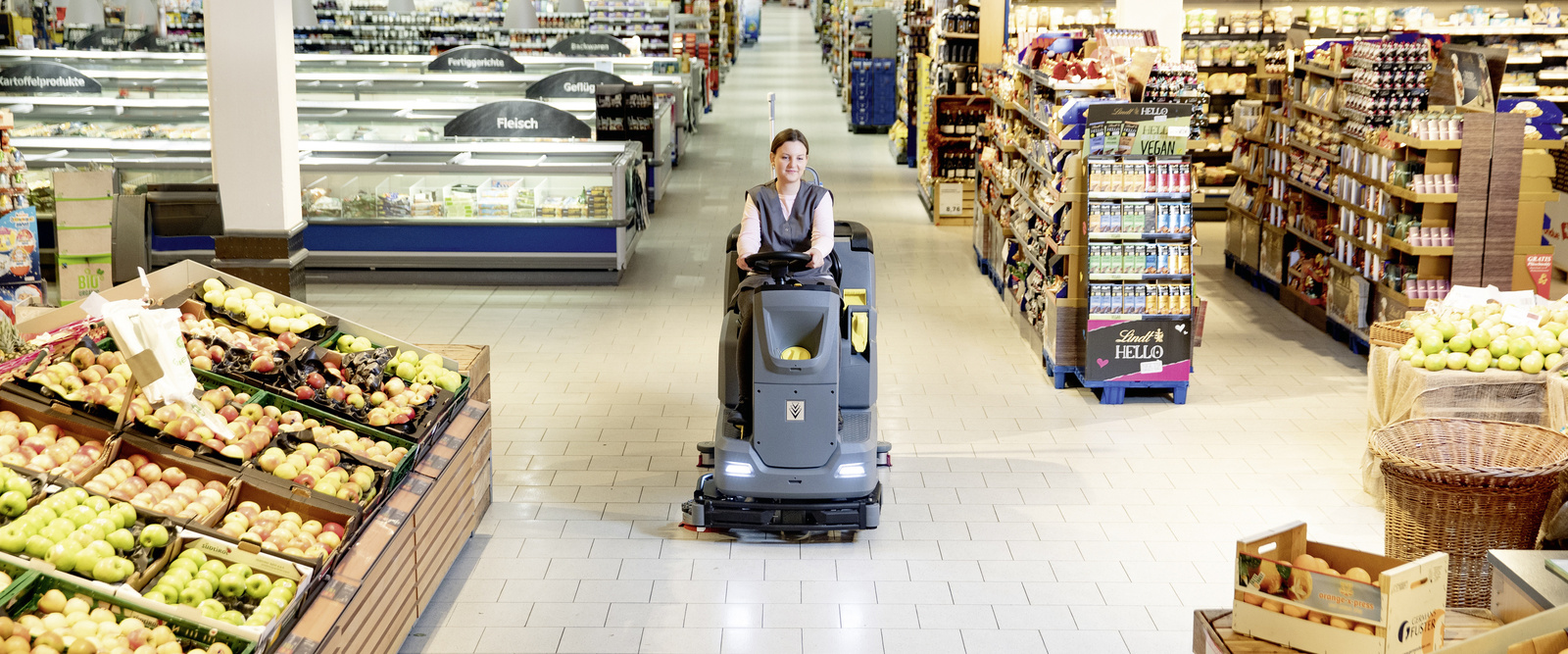
Cleaning outside spaces at supermarkets
Cleanliness begins outside. To keep car parks, access roads, ramps and footpaths clean efficiently, there are various technical tools available to suit the weather. The trolley parks should also be checked regularly.
Clean in all weathers: spotlight on outdoor facilities
When customers arrive, the outdoor facilities should give them the impression of a well-kept store. This not only increases their mood for shopping, but also reduces the amount of dirt that gets inside. In most cases, external service providers are contracted to keep car parks, access roads, ramps and footpaths clean. When the weather is warm and dry, parking areas, access roads, ramps and even footpaths can be cleaned using vacuum sweepers to save time. Push sweepers or ride-on models are ideal for picking up loose dirt from paths, car parks or entrances.


Tip – Maintain cleanliness:
The advantage of vacuum sweepers is that they suck particles straight back up so that parked cars are not covered in a layer of dust as it gets whipped up.
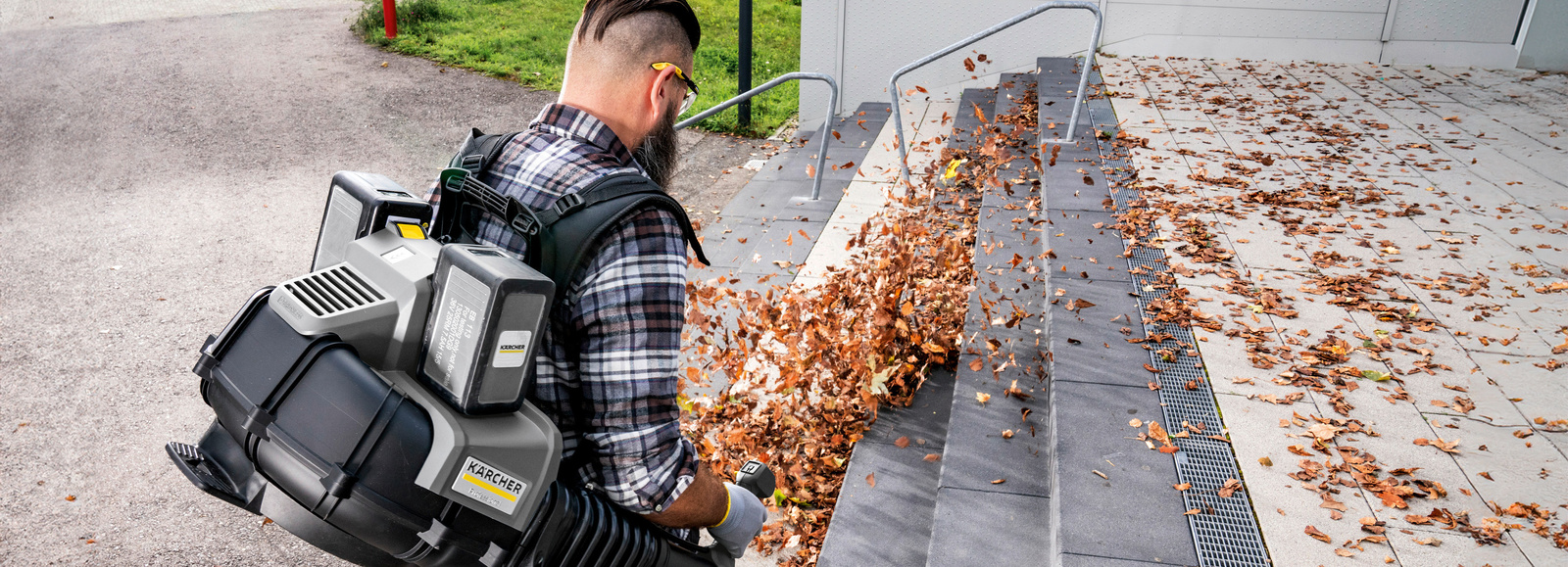
Battery-powered leaf blowers are a user-friendly, quiet and simple option for removing leaves and litter. In the event of snowfall, the appropriate clearing solution must be selected depending on the amount of snow. If there is little snow and the area is small, a manual snow shovel is sufficient. A small 26 hp snow thrower can easily cope with larger amounts of snow. Implement carriers present a further alternative and can be combined with various implements for green area maintenance and winter services and are often used by service providers.
Cleaning outside spaces
Cleaning outside spaces is an important pillar of building cleaning services. Roads, paths and car parks need to be kept tidy, glass surfaces need to be cleaned, and smaller details, from cigarette bins to handrails on external stairs, must not be overlooked. Plus, the entrance area and dirt trap zone must be cleaned regularly. Well worth the effort: a positive first impression is created, the property value is preserved and the amount of cleaning work required indoors is reduced. A good cleaning concept and the right equipment help you to achieve your goal efficiently.
Cleaning outdoor spaces, paths and car parks
Whether dining in a restaurant, shopping in a supermarket, furniture store or shopping centre, or visiting a doctor's surgery or a museum – often the first thing guests do upon arrival is to park their car and make a short walk to the building. There are a number of cleaning methods that can be used to make a positive impression right from the start, to prevent the risk of accidents and to stop dirt being brought in from outside.
Winter services
Climate change and the transport revolution present winter service teams with immense challenges, including environmental impacts such as reduced snowfall, the sudden onset of winter weather or black ice. At the same time, cycle path networks are being massively expanded, as more and more road users switch to two wheels for the sake of the environment or to counter rising fuel costs. What methods are available for local authorities, municipal maintenance depots, external service providers and building service contractors to keep working ecologically, economically and ergonomically? Which implement carriers and implements are used for which jobs?
Green space maintenance
Mowing lawns, landscaping green spaces, keeping hedges and trees in check: the list of jobs for green space maintenance teams is a long one. Powerful cordless machines are now available on the market for many tasks, from brush cutters to pole-mounted pruners and hedge trimmers. There are also various types of mower designed for implement carriers, sustainable options for weed removal and safety vacuum cleaners to aid in the fight against the oak processionary moths.
Facade cleaning
With our new system solution comprising brushes, telescopic lances, attachments and adapters, a variety of cleaning methods can be used flexibly for different cleaning tasks. Whether with low, medium or high pressure, or even vacuuming, it's never been easier to clean facades, glass surfaces, solar panels and floors flexibly and thoroughly, even in hard-to-reach areas.
On a roll with cleanliness: shopping trolleys and trolley parks
Drinks cans, shopping lists and more besides: the space in and around shopping trolley parks is usually anything but immaculate. Sweepers with an easy-to-open coarse dirt flap are a great user-friendly option for removing litter from this area. It can even clear larger items of litter effortlessly. Hot water high-pressure cleaners are a good solution for removing loose dirt and ingrained dirt such as sticky food residue from the trolleys themselves.
Trodden in: reducing the dirt brought inside
In the entrance area, dust control mats and dirt-trapping grids are a good solution to reduce the amount of dirt entering the supermarket. For interim cleaning, we recommend dry vacuum cleaners with a roller brush, which are also available as battery-powered models. In wet weather and with dirt-trapping grids in general, a wet and dry vacuum cleaner should be used. Dust control mats can be given a thorough clean with a high-pressure cleaner, but even with the best care, the mats still need to be replaced from time to time.
Tip 1 – Disinfectant wipe dispensers:
If a disinfectant wipe dispenser is provided, customers can wipe down the handle of the shopping trolley.
Tip 2 – Dust control mats:
The dust control mats should be long enough to accommodate several steps so that they can reliably trap dirt from customers' shoes and the wheels of the shopping trolleys.
Cleaning in supermarkets
There are many individual cleaning tasks specific to different areas in supermarkets. Technology and expertise are needed to keep every element clean: from the glass surfaces in the entrance area to the floors in the fresh produce section, from the oven in the in-store bakery to the shelves on the drinks aisle.


Sparkling clean: glass surfaces in the entrance area
A supermarket's entrance should be light, bright and inviting so that customers feel a warm welcome from the very first moment and are put in a buying mood. For this reason, this area is often fitted with extensive glass surfaces, however these only make a good impression when they are clean. Dirty marks are best removed with a glass cleaner and a microfibre cloth. A window washer with squeegee or a commercial Window Vac efficiently achieves an even cleaning result even on large surfaces. This is not only practical and easy to use, but also beneficial to safety, because the dirty water is vacuumed straight back up, leaving no water drips on the floor to create a slip hazard.
Fruit and vegetable section: floor cleaning
In many supermarkets, the fruit and vegetable section is located soon after the entrance. There, permanently resilient, finely textured floors with a wood effect often create an appealing atmosphere. The disadvantage when cleaning: dirt gets stuck in it very easily, which is particularly problematic when fruit falls to the floor and becomes trampled and sticky. To keep the area clean, loose dirt should initially be swept up. Scrubber dryers with a roller scrubbing head are the tool of choice for the more thorough clean that follows. Fitted with soft roller brushes, dirt can be removed effortlessly even from fine textures and uneven surfaces. Thanks to the extraction feature, the floor dries out straight away and can be walked on again immediately after cleaning.
Tip – Roller scrubbing head:
Scrubber dryers with a roller scrubbing head also pick up coarse dirt.
Cleaning floor coverings
Whether carpeting in a hotel corridor, cement screed in a production hall or wooden flooring in a school building, there are countless floor coverings that are suitable for different loads and ensure safety through properties such as anti-slip design or studs. Cleaning floor coverings is important in some areas to ensure hygiene, while in other areas the focus is on appearance. In any case, well-maintained floor coverings have a longer service life and therefore need to be replaced less frequently. Through regular maintenance cleaning, even the need for labour-intensive deep cleans can be delayed.
Bakery and bread display: kick crumbs to the kerb
Most discounters and supermarkets now offer their customers bread and other baked goods from their own in-store bakery. As well as the ovens, the displays for bread rolls and pastries have to be cleared of crumbs over and over again. A small dry vacuum cleaner or wet and dry vacuum cleaner is a quick and convenient solution.
Bakery vacuum cleaners – with their heat-resistant suction hoses and oven nozzles – are the ideal solution for cleaning hot ovens in supermarket bakeries. They can be used to scrape out and vacuum up residues between batches.


Tip 1 – Keep a vacuum cleaner in the drawers:
To ensure the vacuum cleaner is quickly to hand, it can be stored in the drawers under the goods displays, which actually serve as crumb trays. This saves time and prevents staff having to make unnecessary trips to the cleaning storage.
Tip 2 – Quick floor cleaning:
If there is an in-store coffee shop, the floors there can be cleaned quickly and efficiently with a compact scrubber dryer or a mop with pretreated mop covers.
Hygiene in the bakery: a recipe for cleaning success
Strict standards of cleanliness and hygiene apply wherever food is processed and sold – including in bakeries and their shop fronts. Professional and efficient cleaning not only ensures consumer safety, but also creates a positive overall impression, preserving value and giving confidence in the company. However, there are some specific tasks that require the right technique and approach.
Take care in the drinks aisle: goodbye broken glass and puddles
Many supermarkets stock a wide selection of bottled water, soft drinks or alcoholic beverages. Spontaneous soiling caused by broken glass bottles must be removed immediately to avoid the risk of injury and prevent the build-up of beverage residues. Firstly, remove any large shards of glass manually using a dustpan and hand brush. The cleaner must wear suitable gloves to avoid injury when doing this. A bagless wet and dry vacuum cleaner can then be used to pick up the remaining fragments. The remaining moisture can then be removed using a mop with a microfibre mop cover or a scrubber dryer.
Cleaning hotspot: at and around the bottle deposit machine
In supermarkets that provide facilities to return used drinks bottles, particular care should be taken to inspect the floor regularly throughout the day. To prevent the floor surface from becoming sticky, beverage residues should be removed with a scrubber dryer if necessary. The floor underneath the machine must also be cleaned manually with a mop as and when necessary. A ready-to-use spray cleaner and a microfibre cloth are the ideal combination for cleaning the outer surfaces of the bottle deposit machine. Litter bins must also be checked, emptied and, if necessary, wiped down several times a day.

Tip 1 – Quick-response cleaning:
Extra caution is required with floor coverings made of lime-bound stone, which is sensitive to the acid in fruit juices, etc. To avoid risking damage to the material, spillages must be cleaned up immediately.
Tip 2 – Clean hands:
If wet wipes or disinfectant wipes are available, customers can remove sticky residue from their hands after depositing their bottles.
Cleaning aisles and shelves in the supermarket
Efficient solutions are needed to keep up with the cleaning workload in the aisles and on the shelves. Particularly sensitive areas can be cleaned of germs using steam cleaners. Disinfection is essential to prevent the spread of germs at critical points, including fresh food counters.
Cleaning aisles: scrubber dryer and flat mop
The shelves of supermarkets and discounters are restocked several times a day. This leaves dust and fine shreds of cardboard on the floors of the aisles. A flat mop with a dust-binding cover, which is available in widths from 60 to 160 centimetres, removes these quickly and efficiently. For more thorough cleaning, scrubber dryers with disc or roller technology are an effective solution. The scrubbing heads are tailored to modern shopfitting concepts and are available for every aisle width. Best of all, the machines can usually be driven right up to the edge of furnishings and shelves without any problems.


Cleaning shelves: wet and dry vacuum cleaners or manual methods
Spilled products or dry food residues are not uncommon on supermarket shelves. Wet and dry vacuum cleaners are an effective solution for removing these. The pretreated or spray method is recommended for quick and cost-effective manual cleaning of surfaces. For this, the cleaning team uses twice-folded cloths that are presoaked with the right amount of detergent. Alternatively, the cleaning solution can also be applied using a foam dispenser. Then, each surface is cleaned with a fresh side of the cloth and the cloth is then opened up over and over until all sides have been used. It should then be discarded and replaced with a fresh cloth. These methods can also be used quickly and easily during opening hours without disturbing customers while they are shopping.
Full steam ahead: steam cleaners for hygienically clean results
The high cleaning temperature of steam cleaners and steam vacuums are effective and time-saving tools to combat germs or viruses and thereby ensure hygiene. The steam emerges from the nozzle in very fine droplets and, depending on the machine type, at a temperature of around 100 °C and a pressure of up to 8 bar. They can reliably and effectively clean the plexiglass panels at the checkouts, as well as stainless steel doors and handles, glass counter tops, doors and baby-changing tables in the customer toilets, and even hard-to-reach nooks and crannies.
Cleaning changing rooms and toilet facilities
There are many reasons why careful cleaning is required in toilet facilities and washrooms: depending on the setting, toilets, showers and changing rooms in office buildings, production facilities, hotels, restaurants, sports halls or shopping centres are used by many people. This inevitably leads to people's skin coming into contact with various different surfaces that have been touched by practically all users of the facilities – including door handles, taps or toilet flush buttons. Consequently, microorganisms can pass from one person to the next. This must be prevented by means of defined cleaning sequences.
Disinfection at critical points: germs don't stand a chance
In supermarkets, there are countless surfaces subject to lots of touching: the keypad or touchscreen of the self-service scales in the fruit and vegetable section, for example, the glass displays of the fresh food counters, or the card reader at the checkout. These surfaces should be regularly disinfected to prevent the transfer of germs. However, any protein-based dirt, grease or food residues must be removed by hand before using disinfectants. Why? If there is still protein contamination on the surface, the disinfectant concentrates on this and not on inactivating viruses. On account of this so-called protein error, the efficacy of the disinfectant is no longer guaranteed. Once the surface has been cleaned, disinfectant is distributed evenly so that the surface is completely wetted.
Hygiene takes top priority: the fresh food counter
Wherever food is involved, hygiene and cleanliness are the be-all and end-all. This is the only way to comply with the strict requirements of local or international guidelines, such as HACCP (Hazard Analysis Critical Control Points), without issue. There is an obligation to document cleaning in accordance with the specified cleaning and disinfection plan. However, it is difficult to make a general recommendation for cleaning all surfaces, as the critical points can vary.
In any case, it is important to ensure that the disinfectant is rinsed off with clean drinking water after the contact time. The floor area behind the counter is cramped and usually laid with textured tiles. A compact roller machine is well suited for this. The two-step method is ideal for deep cleaning: firstly, a grease-dissolving detergent is applied to the floor together with water, then in the second step, the floor is scrubbed after the specified contact time and then the dirty water is vacuumed up.
Tip 1 – Rinse surfaces:
For surfaces that come into direct contact with food, the disinfectant residues must be rinsed off with clear water after the contact time.
Tip 2 – Check glass surfaces:
For a neat appearance, the glass surfaces should be checked for fingerprints during the day. A pretreated microfibre cloth, stored alongside a ready-to-use glass cleaner, is a quick and easy option for removing unsightly stains.
Cleaning sales rooms: clean and hygienic
Healthy eating for a healthy life – more and more people are seeing the importance of what's on their plates. Whether using fresh products from a farm shop to make dinner or grabbing a quick lunchtime snack on the go from a kiosk, one thing is vital – there must be scrupulous hygiene standards. Cleanliness and hygiene in sales rooms are fundamental to this. Thorough cleaning is therefore mandatory.
Special requirements for cleaning in supermarkets
There are areas in supermarkets that place very specific demands on the cleaning team: the cold store and freezers, for example. There is special technology for escalators and moving walkways, not to mention an amazingly simple technique for their handrails.
Give dirt the cold shoulder: the cold store
The supermarket's cold store should also be given a thorough clean on a regular basis. Pretreated cloths or microfibre mops with good abrasive properties are well suited for maintenance cleaning while the cold store is in operation. A small scrubber dryer is a suitable aid for cleaning the floor. During cleaning, the door of the cold store should remain closed so as not to reduce the cooling performance. Important: The cold store must be sufficiently ventilated and cleaning staff must wear suitable personal protective equipment (PPE). If a deep clean is due, the refrigeration system is switched off and the food is transferred to another refrigeration unit in advance. With temperatures above freezing, scrubber dryers coupled with the right detergent remove dirt efficiently. Surface cleaners, ideally with suction, are a good addition too. At temperatures above 0 °C, steam cleaners are an efficient solution for hard-to-reach areas such as the rubber seals on doors.

Hygiene in the cold store
Low temperatures, high relevance: cold stores can be found in numerous companies – and where they are found, they are generally integral to operational processes. In hotels and restaurants, in industrial production plants or in supermarkets, cold stores provide the correct conditions for storing perishable and temperature-sensitive goods. For the cold store to function perfectly, it requires specialist professional cleaning that reflects the special conditions.
Defrost, vacuum, wipe: the freezers
The freezer cabinets in supermarkets and discounter stores should be cleaned regularly, too. Before these units are defrosted, all goods must be taken to the cold store so that the cold chain is not interrupted. To clear up the water produced by the defrosting process, we recommend using a scrubber dryer with a suction hose attached instead of the hose for the squeegee. This can also be used to clean up leaks when they arise. To remove any residual water and dirt as ergonomically as possible, a mop with a handle and microfibre mop cover is a user-friendly tool. Seals, hinges, etc. should be given a thorough clean at this point too. A ready-to-use glass cleaner with a microfibre cloth and a Window Vac or surface vacuum cleaner can be used for glass surfaces. The advantage of this is that the surfaces are immediately dry again afterwards. Finally, any disinfection measures necessary can be taken. The refrigeration system is then switched back on and the goods are put back in the freezer cabinets.
Effortless movement, effortless cleaning: moving walkways and escalators
To clean escalators and moving walkways, special machines are needed that do not apply too much water, protecting sensitive electronic components from damage. Escalator cleaners have combs and brushes on the underside. These are placed on the escalator or moving walkway – whilst in motion – to remove the dirt. The handrails must not be forgotten either. There is a simple method for cleaning them: pretreated microfibre cloths soaked in disinfectant are held against the handrail as it moves for completely clean results, simply and efficiently.
Cleaning escalators and moving walkways
Escalators and moving walkways are a common sight in shopping centres, airports, railway stations and other public buildings. The task of cleaning these is often put on the back burner, but over time stubborn dirt builds up, some of which leaves sticky residues. To keep escalators and moving walkways looking as good as new and to give visitors a pleasant impression, they need to be cleaned regularly. Escalator cleaners are a practical solution that minimise the need for manual work.
Suitable products for your area of application
Find a wide range of technology at lightning speed – with the Kärcher Professional product finder
In no time at all, we'll show you the exact Kärcher Professional machine that best suits your specific cleaning task.

